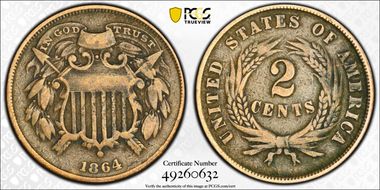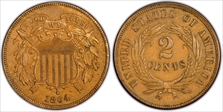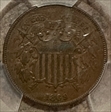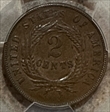Oppizzi Shield Two Cents with Major Varieties, Circulation Strikes (1864 - 1872) 的钱币相册
According to Ron Guth: In 1864, the Philadelphia Mint produced two versions of the Two Cent piece, both relating to the size of the letters in the motto IN GOD WE TRUST. The Large Motto replaced the Small Motto and became the model for the remaining years of the Two Cent type. The Large Motto variety is the more common of the two. Cherry-pickers should keep a lookout for the following scarce and interesting varieties: 1864 Large Motto, Doubled Die Obverse 1864 Large Motto, Triple Punched Date 1864 Large Motto, Reverse clashed with the obverse die of an Indian Head Cent! The Act of April 22, 1864, which changed the weight and composition of the cent, including a provision for a bronze two-cent piece. The weight was specified at 96 grains, the alloy being the same as for the cent. The two-cent piece is one of the shortest-lived issues of the United States. The motto IN GOD WE TRUST appeared for the first time on the new coin, with the support of Treasury Secretary Salmon P. Chase. There are two varieties for the first year of issue, 1864; the Small Motto, which is scarce, and the Large Motto. The stem to the leaf shows plainly on the Small Motto variety. There is no stem on the Large Motto. The first T in TRUST is very close to the ribbon crease at left on the Small Motto variety; there is a 1 mm gap on the Large Motto variety. The shield device is very similar to that on the nickel five-cent piece introduced in 1866.
According to Ron Guth: In 1864, the Philadelphia Mint produced two versions of the Two Cent piece, both relating to the size of the letters in the motto IN GOD WE TRUST. The Large Motto replaced the Small Motto and became the model for the remaining years of the Two Cent type. The Large Motto variety is the more common of the two. Cherry-pickers should keep a lookout for the following scarce and interesting varieties: 1864 Large Motto, Doubled Die Obverse 1864 Large Motto, Triple Punched Date 1864 Large Motto, Reverse clashed with the obverse die of an Indian Head Cent! The Act of April 22, 1864, which changed the weight and composition of the cent, including a provision for a bronze two-cent piece. The weight was specified at 96 grains, the alloy being the same as for the cent. The two-cent piece is one of the shortest-lived issues of the United States. The motto IN GOD WE TRUST appeared for the first time on the new coin, with the support of Treasury Secretary Salmon P. Chase. There are two varieties for the first year of issue, 1864; the Small Motto, which is scarce, and the Large Motto. The stem to the leaf shows plainly on the Small Motto variety. There is no stem on the Large Motto. The first T in TRUST is very close to the ribbon crease at left on the Small Motto variety; there is a 1 mm gap on the Large Motto variety. The shield device is very similar to that on the nickel five-cent piece introduced in 1866.
According to Ron Guth: In 1864, the Philadelphia Mint produced two versions of the Two Cent piece, both relating to the size of the letters in the motto IN GOD WE TRUST. The Large Motto replaced the Small Motto and became the model for the remaining years of the Two Cent type. The Large Motto variety is the more common of the two. Cherry-pickers should keep a lookout for the following scarce and interesting varieties: 1864 Large Motto, Doubled Die Obverse 1864 Large Motto, Triple Punched Date 1864 Large Motto, Reverse clashed with the obverse die of an Indian Head Cent! The Act of April 22, 1864, which changed the weight and composition of the cent, including a provision for a bronze two-cent piece. The weight was specified at 96 grains, the alloy being the same as for the cent. The two-cent piece is one of the shortest-lived issues of the United States. The motto IN GOD WE TRUST appeared for the first time on the new coin, with the support of Treasury Secretary Salmon P. Chase. There are two varieties for the first year of issue, 1864; the Small Motto, which is scarce, and the Large Motto. The stem to the leaf shows plainly on the Small Motto variety. There is no stem on the Large Motto. The first T in TRUST is very close to the ribbon crease at left on the Small Motto variety; there is a 1 mm gap on the Large Motto variety. The shield device is very similar to that on the nickel five-cent piece introduced in 1866.
According to Ron Guth: In 1864, the Philadelphia Mint produced two versions of the Two Cent piece, both relating to the size of the letters in the motto IN GOD WE TRUST. The Large Motto replaced the Small Motto and became the model for the remaining years of the Two Cent type. The Large Motto variety is the more common of the two. Cherry-pickers should keep a lookout for the following scarce and interesting varieties: 1864 Large Motto, Doubled Die Obverse 1864 Large Motto, Triple Punched Date 1864 Large Motto, Reverse clashed with the obverse die of an Indian Head Cent! The Act of April 22, 1864, which changed the weight and composition of the cent, including a provision for a bronze two-cent piece. The weight was specified at 96 grains, the alloy being the same as for the cent. The two-cent piece is one of the shortest-lived issues of the United States. The motto IN GOD WE TRUST appeared for the first time on the new coin, with the support of Treasury Secretary Salmon P. Chase. There are two varieties for the first year of issue, 1864; the Small Motto, which is scarce, and the Large Motto. The stem to the leaf shows plainly on the Small Motto variety. There is no stem on the Large Motto. The first T in TRUST is very close to the ribbon crease at left on the Small Motto variety; there is a 1 mm gap on the Large Motto variety. The shield device is very similar to that on the nickel five-cent piece introduced in 1866.
The Act of April 22, 1864, which changed the weight and composition of the cent, including a provision for a bronze two-cent piece. The weight was specified at 96 grains, the alloy being the same as for the cent. The two-cent piece is one of the shortest-lived issues of the United States. The motto IN GOD WE TRUST appeared for the first time on the new coin, with the support of Treasury Secretary Salmon P. Chase. The shield device is very similar to that on the nickel five-cent piece introduced in 1866.
The Act of April 22, 1864, which changed the weight and composition of the cent, including a provision for a bronze two-cent piece. The weight was specified at 96 grains, the alloy being the same as for the cent. The two-cent piece is one of the shortest-lived issues of the United States. The motto IN GOD WE TRUST appeared for the first time on the new coin, with the support of Treasury Secretary Salmon P. Chase. The shield device is very similar to that on the nickel five-cent piece introduced in 1866.
The Act of April 22, 1864, which changed the weight and composition of the cent, including a provision for a bronze two-cent piece. The weight was specified at 96 grains, the alloy being the same as for the cent. The two-cent piece is one of the shortest-lived issues of the United States. The motto IN GOD WE TRUST appeared for the first time on the new coin, with the support of Treasury Secretary Salmon P. Chase. The shield device is very similar to that on the nickel five-cent piece introduced in 1866.
The Act of April 22, 1864, which changed the weight and composition of the cent, including a provision for a bronze two-cent piece. The weight was specified at 96 grains, the alloy being the same as for the cent. The two-cent piece is one of the shortest-lived issues of the United States. The motto IN GOD WE TRUST appeared for the first time on the new coin, with the support of Treasury Secretary Salmon P. Chase. The shield device is very similar to that on the nickel five-cent piece introduced in 1866.
The Act of April 22, 1864, which changed the weight and composition of the cent, including a provision for a bronze two-cent piece. The weight was specified at 96 grains, the alloy being the same as for the cent. The two-cent piece is one of the shortest-lived issues of the United States. The motto IN GOD WE TRUST appeared for the first time on the new coin, with the support of Treasury Secretary Salmon P. Chase. The shield device is very similar to that on the nickel five-cent piece introduced in 1866.
The Act of April 22, 1864, which changed the weight and composition of the cent, including a provision for a bronze two-cent piece. The weight was specified at 96 grains, the alloy being the same as for the cent. The two-cent piece is one of the shortest-lived issues of the United States. The motto IN GOD WE TRUST appeared for the first time on the new coin, with the support of Treasury Secretary Salmon P. Chase. The shield device is very similar to that on the nickel five-cent piece introduced in 1866.
The Act of April 22, 1864, which changed the weight and composition of the cent, including a provision for a bronze two-cent piece. The weight was specified at 96 grains, the alloy being the same as for the cent. The two-cent piece is one of the shortest-lived issues of the United States. The motto IN GOD WE TRUST appeared for the first time on the new coin, with the support of Treasury Secretary Salmon P. Chase. The shield device is very similar to that on the nickel five-cent piece introduced in 1866.
The Act of April 22, 1864, which changed the weight and composition of the cent, including a provision for a bronze two-cent piece. The weight was specified at 96 grains, the alloy being the same as for the cent. The two-cent piece is one of the shortest-lived issues of the United States. The motto IN GOD WE TRUST appeared for the first time on the new coin, with the support of Treasury Secretary Salmon P. Chase. The shield device is very similar to that on the nickel five-cent piece introduced in 1866.
The Act of April 22, 1864, which changed the weight and composition of the cent, including a provision for a bronze two-cent piece. The weight was specified at 96 grains, the alloy being the same as for the cent. The two-cent piece is one of the shortest-lived issues of the United States. The motto IN GOD WE TRUST appeared for the first time on the new coin, with the support of Treasury Secretary Salmon P. Chase. The shield device is very similar to that on the nickel five-cent piece introduced in 1866.
The Act of April 22, 1864, which changed the weight and composition of the cent, including a provision for a bronze two-cent piece. The weight was specified at 96 grains, the alloy being the same as for the cent. The two-cent piece is one of the shortest-lived issues of the United States. The motto IN GOD WE TRUST appeared for the first time on the new coin, with the support of Treasury Secretary Salmon P. Chase. The shield device is very similar to that on the nickel five-cent piece introduced in 1866.
The Act of April 22, 1864, which changed the weight and composition of the cent, including a provision for a bronze two-cent piece. The weight was specified at 96 grains, the alloy being the same as for the cent. The two-cent piece is one of the shortest-lived issues of the United States. The motto IN GOD WE TRUST appeared for the first time on the new coin, with the support of Treasury Secretary Salmon P. Chase. The shield device is very similar to that on the nickel five-cent piece introduced in 1866.
The Act of April 22, 1864, which changed the weight and composition of the cent, including a provision for a bronze two-cent piece. The weight was specified at 96 grains, the alloy being the same as for the cent. The two-cent piece is one of the shortest-lived issues of the United States. The motto IN GOD WE TRUST appeared for the first time on the new coin, with the support of Treasury Secretary Salmon P. Chase. The shield device is very similar to that on the nickel five-cent piece introduced in 1866.

















































